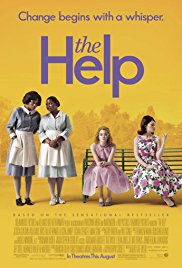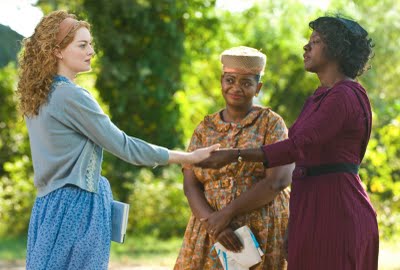After the film has been watched, engage the class in a discussion about the movie.
1. [Ask the following question first of one student and then another until no one in the class has any ideas left. Start with the less capable students and move on to more perceptive students.] Describe how racism or classism interfered with an important personal relationship in this story.
Suggested Response:
This occurred in almost every relationship. For example, between white children and the black women who raised them, between the maids and the women for whom they worked (including Skeeter and Constantine), between Skeeter and her mother, and between Skeeter and her boyfriend, Stuart. Note in the discussion that it must do something terrible to a child’s psyche to learn that his or her primary caregiver was an inferior person. For students who have only seen the movie, tell them that in the book Constantine’s father was a white man who used to visit her mother every Saturday. Constantine was his favorite daughter, and the most important thing he said to her, with tears in his eyes, was “I’m sorry.” (pp. 77 – 79) As sometimes happened, when Constantine had a child, the baby turned out white, although the father was a black man. But a black woman with a white child could not exist in the segregated South, so Constantine sent her daughter north to Chicago to live in an orphanage while Constantine stayed in Jackson and raised Skeeter. (pp. 100 & 101) This is just another example of how racism distorted personal relationships.
2. What role does class play in this film?
Suggested Response:
Celia Foote is from a family and an area with less class than the other white women in the movie. She is treated terribly by them: they won’t return her phone calls; they won’t allow her to work on the charity drives, etc. It isn’t just that Celia took Hilly Holbrook’s boyfriend, but that she did this and was the lower class that drove Hilly to hate her so much. There is also social climbing shown among the white women. This is a class-based activity.
3. Aibileen is the first of the maids to come forth with stories about her life as a housekeeper and a nanny. What personal characteristics enable her to risk such a bold move?
Suggested Response:
Aibileen has suffered terribly in her life, most dramatically from the unjust death of her only child. Respect for her son, who had wanted to be a writer, seems to drive her to reveal her truths. She also has no one depending on her, in contrast with Minnie, who has children still living at home. Aibileen seems to be aware that times are changing and her courage, dedication to friends, and sense of justice motivate her to come forward.
4. Males play minor roles in this film. Which male characters seem to contribute to the theme of female empowerment and what do they do that advances the women in their lives?
Suggested Response:
Johnny Foote, Celia’s husband, supports and loves her despite the class differences between them. Stuart Whitworth, Skeeter’s boyfriend, unwittingly helps Skeeter move on with her life. He breaks up with her when he discovers her role in publishing the stories about the black housekeepers, thus freeing her to leave for New York for a writer’s life.
5. Skeeter’s mother experiences redemption in this film. What lies behind this powerful change and which scene shows the redemption?
Suggested Response:
Skeeter’s mother, Charlotte, who is dying of cancer, is one of the few white women to show remorse and assume a degree of responsibility for the treatment of blacks by their white employers. Skeeter’s broken heart, caused by the unexplained loss of Constantine, her own personal black nanny, seems to trigger remorse in the older woman and she then defends her daughter’s efforts on behalf of the maids in a scene with a highly rattled Hilly.
6. Various discussions and glimpses of news on television reveal the time period in which the story is set. What contribution is made to the progress in the story by these references to the ongoing Civil Rights Movement?
Suggested Response:
It can be asserted that the unrest and excitement caused by the promise of social change give the black women hope, courage and the ability to see past their narrow lives to a greater cause, thus enabling them to speak more freely. These clips also anchor the movie in its chronological and social context.
7. What differences do you see in the friendships shown among the employers and the friendships among the maids? Give examples.
Suggested Response:
Answers will vary. Be sure each response is backed up by reference to a scene or to dialogue. Some may suggest that the women who employ the maids are highly conscious of social status in their friendships and adhere closely to the set of unspoken rules that dominate their relationships. The maids, in contrast, are usually caring, open, and loyal to one another as individuals. 8. What does it do to a person’s self-respect if the culture around that person treats him or her with disrespect? Suggested Response: Most people will adopt the judgment of their society and have little self-respect. It is only exceptional people who will be able to develop strong self-respect while living in a culture that doesn’t respect them.
9. Hilly Holbrook wanted separate bathrooms from the maids. In the American South in the first half of the 20th century, whites espoused the doctrine of “separate but equal.” This was supposed to keep the races separate but treat them equally. Did it work in practice? Can it ever work in a society in which one race has all the power?
Suggested Response:
As a practical matter, budget considerations will almost always mean that the separate facilities for the less powerful race will be inferior to what is provided for the more powerful race. In addition, the fact that one race wanted to be separate from the other is a demonstration of disrespect that injures the self-image of members of the less powerful race.
See also TWM’s Discussion Questions for Use With any Film that is a Work of Fiction and Lesson Plans Using Film Adaptations of Novels, Short Stories or Plays.








